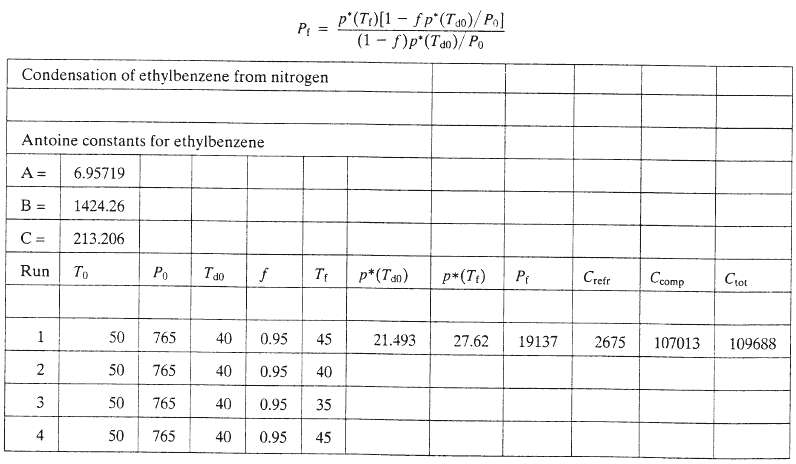Recovery of a solvent vapor from a gas stream by condensation can be achieved by cooling the
Question:
Recovery of a solvent vapor from a gas stream by condensation can be achieved by cooling the gas, by compressing it, or by a combination of these operations. The greater the compression, the less cooling is needed.
(a) A gas mixture at a pressure P0 and temperature T0 is the feed to a recovery process. A single condensable vapor and several non-condensable gases are present in the mixture, giving the feed a dew point of T. A fraction f of the vapor is to be condensed. The vapor pressure p* (T) of the condensable component may be expressed as a function of temperature with the Antoine equation. For a gas feed rate of %, draw and label a flowchart. Then derive the following relationship for the final condenser pressure in terms of the final temperature Tt and the specified feed conditions and fractional solvent recovery:
(b) The cost of refrigeration equipment and the compressor can be estimated using the empirical formulas9?C refr?($/k mol feed gas) = 2000 + 27(?T)2?C comp($/k mol feed gas) = 4500 + 5.58 (?P) where ?T(?C) = Tt ? T0 and ?P(mm Hg) = Pt ? P0. Your task is to prepare a spreadsheet to estimate the operating cost of a process in which ethylbenzene is recovered from an ethylbenzene?nitrogen gas mixture. The spreadsheet should have the following form: Enter the values in the first six columns of the first row of the 12-column table (1, 50, ... ,45) and enter formulas in the next six columns (including C tot = C refr + C comp). The row shown above for Run 1 contains results for a feed gas at 50?C and 765 mm Fig with a dew point of 40?C, from which 95% of the ethylbenzene is to be recovered by cooling the mixture to 45?C. The output shows that the mixture must be compressed to 19,137 mm Hg to achieve the desired recovery, and that the costs of refrigeration and compression and the total cost ($/k mol feed gas) are, respectively, $2675, $107,013, and $109.688. When you have constructed the spreadsheet and duplicated the results just described for Run 1, (i) copy that row into the next three rows and change the values in the first six columns to duplicate those shown above; (ii) let Runs 2 and 3 stand: and (iii) in Run 4 vary the value of Tf to find the most cost-effective final temperature and pressure for the given feed conditions and fractional recovery, noting what happens to Pf, C refr, C comp, and C as you carry out your search.
(c) Use the results for Runs 1?3 to deduce the effect of lowering the final temperature on the pressure required achieving a specified fractional recovery of ethylbenzene. Explain why this result makes sense.
(d) Summarize the effect of T( on the refrigeration and compression costs and explain why the total cost has a minimum.

Step by Step Answer:

Elementary Principles of Chemical Processes
ISBN: 978-0471720638
3rd Edition
Authors: Richard M. Felder, Ronald W. Rousseau





